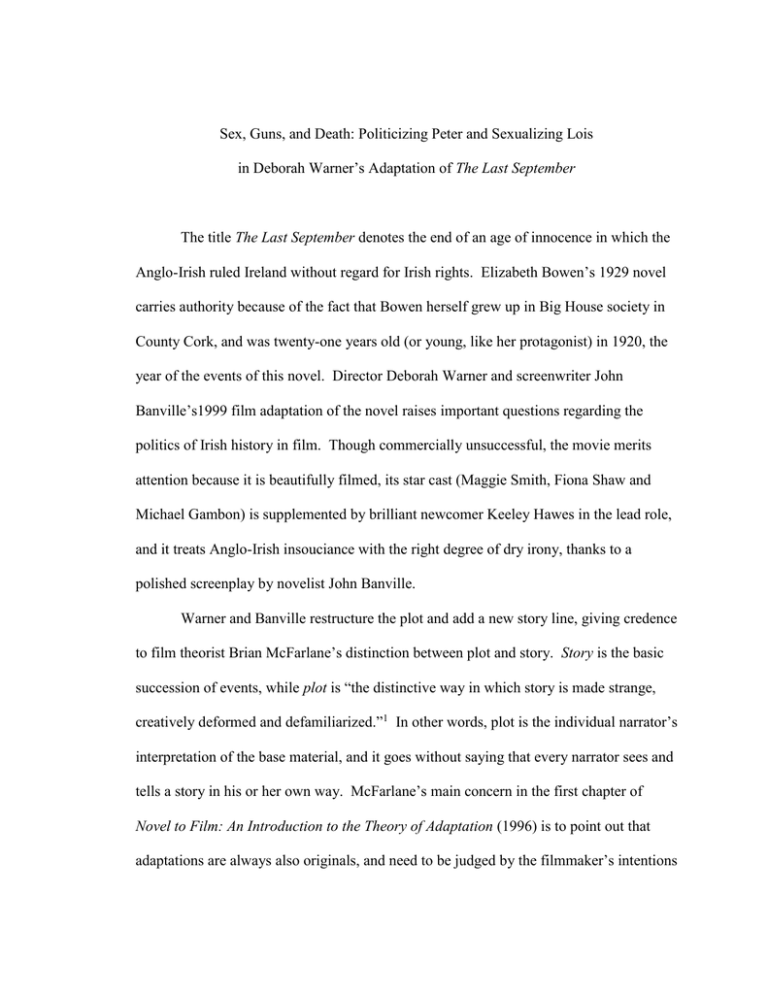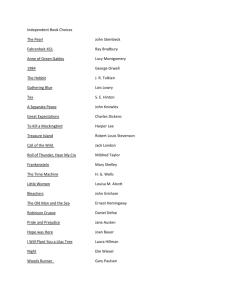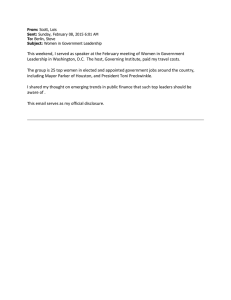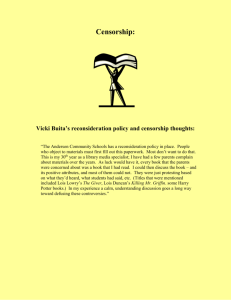
Sex, Guns, and Death: Politicizing Peter and Sexualizing Lois
in Deborah Warner’s Adaptation of The Last September
The title The Last September denotes the end of an age of innocence in which the
Anglo-Irish ruled Ireland without regard for Irish rights. Elizabeth Bowen’s 1929 novel
carries authority because of the fact that Bowen herself grew up in Big House society in
County Cork, and was twenty-one years old (or young, like her protagonist) in 1920, the
year of the events of this novel. Director Deborah Warner and screenwriter John
Banville’s1999 film adaptation of the novel raises important questions regarding the
politics of Irish history in film. Though commercially unsuccessful, the movie merits
attention because it is beautifully filmed, its star cast (Maggie Smith, Fiona Shaw and
Michael Gambon) is supplemented by brilliant newcomer Keeley Hawes in the lead role,
and it treats Anglo-Irish insouciance with the right degree of dry irony, thanks to a
polished screenplay by novelist John Banville.
Warner and Banville restructure the plot and add a new story line, giving credence
to film theorist Brian McFarlane’s distinction between plot and story. Story is the basic
succession of events, while plot is “the distinctive way in which story is made strange,
creatively deformed and defamiliarized.”1 In other words, plot is the individual narrator’s
interpretation of the base material, and it goes without saying that every narrator sees and
tells a story in his or her own way. McFarlane’s main concern in the first chapter of
Novel to Film: An Introduction to the Theory of Adaptation (1996) is to point out that
adaptations are always also originals, and need to be judged by the filmmaker’s intentions
2
regarding fidelity or non-fidelity to the original, rather than a dogged insistence that the
film reproduce the novel verbatim, something it cannot do because film and literature
involve two different “systems of signification,“ one verbal and therefore symbolic, the
other visual and therefore perceptual.2
Given that an adaptation is entitled to be an interpretation, what is left to talk
about? Something very interesting to observers of culture--that is, how and why the
changes occurred, and the ways in which these changes reflect upon the different political
and artistic climates of the times in which the novel and the film, respectively, were
made. We cannot underestimate the power of the political moment to shape an
adaptation. Consider Francis Ford Coppola’s remake of Joseph Conrad’s Heart of
Darkness during the throes of postwar angst in 1979. Enchanted by the relevance of
Marlow’s search for the evil depths of man in conditions of early twentieth-century
colonial conquest, Coppola juxtaposed this quest to his own time and place, and had
Martin Sheen play a Marlow (Captain Willard) who was fascinated by the colonialism of
war and by what happens when war anesthetizes men to their own values. It is not that
Conrad took the side of the colonizers while Coppola took the side of the Vietnamese, but
rather that issues of colonialism (and of evil) have been problematized—perhaps even
more than by the sophisticated mind of Conrad--by the intellectual and political
developments of the twentieth century. Freud popularized the concept of ambivalence,
an emotional state well acted by Marlon Brando and Martin Sheen in Apocalypse Now.
Postcolonial theorist Homi Bhabha applied Freudian ambivalence to relations of
colonizer and colonized. Bhabhaian ambivalence is rampant in Warner and Banville’s
film; the uncertain identity of her Anglo-Irish uncle and aunt are only magnified in Lois
3
because of her adolescence. They give her no strong role models, either for political
convictions or for tolerance, her uncle going so far as to order her British soldier
boyfriend to kill her IRA lover because “that seems to be the way to take care of it.”
This essay examines the film The Last September with the intention of exploring
why certain “cardinal functions” were changed, and how these changes affect the
political impact of the film. Cardinal functions are those actions in a text which “open up
alternatives of consequence to the development of the story.”3 A filmmaker who wishes
to remain true to the letter and spirit of the original does not change these functions. A
filmmaker who uses the text as a starting point for his or her own interpretation (not only
of the novel but of the life which it represents) will change some of the cardinal
functions. Warner and Banville are the latter type of filmmakers. They add the cardinal
function of Lois and Peter’s sexual attraction, which shifts the emphasis from Bowen’s
nonpartisan but parodic depiction of Anglo-Irish aristocracy, to a more balanced
representation of both sides of the colonial conflict. A secondary cardinal function that
Banville and Warner radically alter is what happens to Lois at the end of the story. In the
novel, she is sent to live with a family in France so that her aunt can control and protect
her. In the film, she accompanies her friend Marda on Marda’s honeymoon, hoping to
have romantic adventures, and embracing the legacy of her absent father, a so-called
bounder. Banville and Warner embolden Lois, and give her the willpower and
independence characteristic of a late twentieth-century heroine rather than the more
submissive, convention-bound role of a turn-of-the-century female.
My analysis draws on two main concepts from film theory—Laura Mulvey’s
description of scopophilic eroticism, which Banville and Warner partially subvert by
4
granting Lois agency in looking, and Brian McFarlane’s exposition of film’s
intertextuality with the prevailing cultural and social climate at the time of its making. A
true scopophiliac (one who enjoys looking at potential sexual objects—to be
differentiated from a voyeur, who substitutes watching for doing), Lois’s nearly constant
companion is her spyglass, providing her intimate looks at the objects of her interest
while at the same time suggesting her distance or detachment from them. Whereas
Mulvey speaks of scopophilia as the movie watcher’s normal condition, his or her
pleasure of looking can be doubled when modeled by the protagonist of a film. We love
to watch Lois watching, and her prop, the spyglass, functions also as a phallic symbol in
humorous and clever ways. Although Lois herself becomes a sexual object to the camera
(and audience’s) eye, she also is the agent in her own subject position of looking at
others, thereby subverting Laura Mulvey’s theory that woman is always an image
connoting “to-be-looked-at-ness,” while man is always “bearer of the look.”4
The film must also be considered in the context of its time—1999, the year after
the Good Friday Peace Accord in Northern Ireland. Considering McFarlane’s notion of
film’s intertextuality with contemporary culture, we note that the film develops the
Republican side to Bowen’s story. It suggests an alternate point of view, due to the fact
that the filmmakers were working in a time and place that had learned to take Republican
concerns seriously and had much invested in actuating the new peace accord between
Northern Ireland and the Republic.
A review of the book’s plot—its cardinal functions—will facilitate an analysis of
the movie’s modifications. The story centers on nineteen-year-old Lois Farquar (played
by Keeley Hawes), orphaned Irish girl living with her upper class uncle, Sir Richard
5
(Michael Gambon), and his wife, Lady Myra (Maggie Smith), on a beautiful County
Cork estate called Danielstown. Gerald Lesworth (David Tennant), a British Army
Captain charged with protecting the locals from rebel attacks, loves Lois, but she is
uncertain of her own feelings, finding him too “solid” and “absolute.” Spending time
with wittier, more sophisticated house guests prejudices Lois against Gerald, whose
simple beliefs are ”love of his dog, mother, country, school, a friend or two, and—
crowningly—Lois.”5 Lois finds him too absolute; the fact that she is everything to him is
the kernel of the problem.
Richard and Myra’s house guests further complicate Lois’s confused feelings.
She thinks she might be in love with Hugo Montmorency (Lambert Wilson), a physically
attractive member of Big House society who is unhappily married to an older woman,
Francie (Jane Birkin). The couple arrives at Danielstown homeless, since they sold their
own house with plans to emigrate to Canada, but subsequently lost the nerve. Now, they
make a lifestyle out of staying with other Ascendancy types. Ineffectual and lost, they
represent the wan etiolation of body and spirit characteristic of a doomed way of life. A
more vibrant guest, Marda Norton (Fiona Shaw), somewhat proudly calls herself a
“vamp”; she has been loved by several men, but has only recently, at the last gasp of
eligibility, agreed to marry a rich Englishman. Even Lady Naylor’s nephew Laurence
(Jonathan Slinger), a pro-Republican Oxford undergraduate with “all the wrong politics,”
is more complex than Gerald. Gerald, however, is thoroughly decent, which Lois
recognizes but fails to find thoroughly magnetic at her age. In the background of Big
House events such as tennis parties and army dances, rumble the sounds and sights of the
Troubles. IRA men ambush the police barracks, killing several officers. Peter Connor
6
(Gary Lydon), a neighboring peasant farmer, gets captured for his involvement in the
attack, but later escapes. Patrolling lorries light the front yard in the evening, when the
family is trying to relax. Lois spots an unidentified IRA man making a short cut through
her uncle’s property, and is inspired by his sense of purpose.
Meanwhile, Lady Naylor discourages Gerald from a match with Lois on the basis
of money and class. Gerald bravely attempts to woo Lois regardless of the warnings of
her adoptive aunt, but she remains uncertain. Her girlish infatuation with cynical, faintly
man-hating Marda, and Marda’s exhortation to experience as much life as she can may be
the reason why Lois cannot commit to Gerald. Gerald’s death prevents her from having
to make a decision, and reminds us of Sir Richard’s clever remark about Hugo: “He’ll
probably pre-decease her [his older wife]; it would be just his way of avoiding things.”
After the trauma, Lady Naylor whisks Lois off to France to work on her French, changing
her mind about art school for no clear reason. The last scene is from the point of view of
a subjective, omniscient voice, whose chief emotion is nostalgia for a way of life that has
been extinguished by IRA men. They burn Danielstown, but Lady Naylor and Sir
Richard continue to cover their feelings and cloak their understanding about why this has
occurred.
The film version of The Last September was released in 1999, with a cast of wellknown British and Irish actors including Maggie Smith, Michael Gambon, and Fiona
Shaw, and newcomer Keeley Hawes as Lois. British and Irish producers collaborated,
using John Banville’s screenplay. Living in Dublin, Banville has a distinguished career
as a novelist and has been literary editor at the Irish Times since 1988. What attracted
him to Bowen’s novel? In a 1997 interview, Ron Hogan compared one of Banville’s
7
fictional characters to Oscar Wilde and George Bernard Shaw, who went from Ireland to
England, and “became more English than the English themselves by becoming parodies
of the English.”6 Banville responded that he was obsessed with the English because
Ireland is in the strange position of being only seventy miles away from its former
colonizer. In another interview, this one with Mike Murphy, Banville confesses to
having an inferiority complex towards university-educated people and recognizes the
strange intensities of the auto-didact.7 One can see how he might be fascinated by
Elizabeth Bowen and her characters, the neither-good-nor-bad but rather obtuse AngloIrish who are a living parody of the English at the same time that they “identify Irish.” A
well-developed sense of the outsider might attract any writer to Lois, to shell-shocked
Captain Daventry, to love-hardened Marda Norton, and to the other marginalized
characters in Bowen’s book.
In her own field, Deborah Warner is as successful as Banville. Born in the
Cotswolds in 1959, she started as a stage director at the age of twenty-one. At twentyeight, she was invited to join the Royal Shakespeare Company as one of that
organization’s few female directors. Later, she became Associate Director of the Royal
National Theater. Warner likes to mix things up; her stated objective is “to take a classic
and make it real for now.”8 She has been alternately criticized and praised for her
original interpretations and daring innovations on stage and film. Beckett’s estate shut
down her version of “Footfalls” for its deviations, and “Richard II” starred Fiona Shaw as
the King.9 She staged the bloodiest of Shakespeare’s tragedies, Titus Andronicus, and as
we see in The Last September, she does not hold back from depicting rape or murder.
Unafraid of difficult undertakings, she adapted Eliot’s “The Waste Land” for the stage.
8
Warner’s long-time working relationship with Fiona Shaw may explain the prominence
the actress assumes in Warner’s Last September as Marda. Marda becomes a stronger
role model for Lois in the film, and her sexual waywardness is seen as admirable rather
than the reverse.
Taken together, John Banville and Deborah Warner bring considerable talent and
personality to the project. A literary Irishman who sees himself as an outsider and is
obsessed with England’s power, plus a feminist Englishwoman who likes to shake up the
theatrical establishment with her different takes on classic material, such as casting Fiona
Shaw in the title role of Richard II. The year is 1999 (actually 1997-8 when the project is
under construction) and the biggest news in Ireland is the peace agreement intended to
end thirty years of terror and bloodshed. Banville and Warner have sufficient reason to
re-script Bowen’s material. Although she also loves and understands them, Elizabeth
Bowen parodies the insouciance of the Anglo-Irish on the eve of their demise
(September, 1920). They do not understand why their neighbors are unhappy, nor that
the changes are going to be final. Her representation of British law-and-order, Captain
Gerald Lesworth, is of a man who is similarly stereotypical, flat, and uninspiring.
On the other hand, Bowen does not take a pro-rebel or pro-republican stance. She
does not even flesh out an Irish-Irish, as opposed to Anglo-Irish character. Banville and
Warner do. Although their Peter Connolly (Connor in the book) is fairly onedimensional himself, they garner sympathy for him in a scene in which a small group of
Black-and-Tans raid his father’s general store and urinate on the floor. We also see him
through Lois’s eyes; in contrast to her legitimate suitor Gerald, Peter has manly
confidence, both in his political cause, and in his sexual desire. While this leads to sexual
9
assault, Lois does return for more. Gerald’s indecisiveness annoys her, and the opposite
is exciting for her.
Why do Banville and Warner expand Peter’s character and give us some
sympathy for a rebel? Perhaps because in 1999, both Ireland and England are invested in
fair representation of both sides of the conflict and dedicated to good will efforts to end
prejudice and hostility. There is much at stake since the Accord is already breaking down
in its second year, and will be deadlocked and suspended in 2002, due to the continuation
of IRA paramilitary activities, to accusations of IRA spies in Stormont, and to stalling by
London authorities.
Despite the political background, The Last September does not play like a
political manifesto. The camera is experimental and subjective, the focus ranging from
sharp to dreamy, the colors deep and rich. Cinematographer Slawomir Idziak is best
known for his work on Krzysztof Kieslowski’s Decalogue; lush interiors and exteriors,
plus the camera’s skill at evoking symbolic value from both objects and places, mark this
man’s characteristic endeavors. The film is both beautiful and engaging in its own right,
but as so many literary adaptations, it lacks the philosophical tone of the book.
However, it would be impossible to recreate this effect without voiceover narration, and
voiceover narration could very well ruin the atmosphere, since we are seeing events
through the eyes of Lois, who has not yet gained the age of philosophy.
Bowen’s writing resembles Virignia Woolf’s in its attention to the physical detail
of homes and their furnishings, in its expansion of luminous moments of consciousness,
in its ironies about subjective perception. One of Bowen’s most characteristic ploys is
her personification of inanimate things, particularly houses. In this book, the
10
Danielstown estate is very much a character, symbolizing the exhaustion of the AngloIrish way of life in Ireland. Similarly to most of the characters in the book, Danielstown
is passive and lacking in agency. Yet the aesthetic expressiveness of its many parts tells
a vivid story. While Idziak’s camera lovingly displays the expensive adornments of the
country house and gardens, the absence of spoken narration erases the philosophical
caress of Bowen’s voice, and it is hard always to know what the camera means. When
Lois is distracted from Gerald’s love declaration by catching her reflection in a portrait of
one of her ancestors, is she “going tribal,” identifying with the dead past instead of
Gerald’s pulsating presence? Or, is she repulsed by the simpering effeminacy of that
pampered lady, and thrust towards an unknown future, grabbing at stray opportunities
such as military suitors from the other tribe—that of Englishmen?
Whereas Bowen’s prose makes remarkable use of passive voice, as if to suggest
that both Lois and her guardians are pawns of larger historical forces, Banville’s
screenplay grants agency to the usual movie industry culprits, lust and war. These appear
in the unattractive person of Peter Connolly (renamed after the book’s Connor),
Republican rebel and despoiler of female innocence. In the movie, the greatest change is
that Lois loves Peter Connolly. Her attraction to him is inversely proportional to her
feelings about Gerald—the more she likes Peter, the less she wants Gerald. Her one
serious talk with Marda only increases her instinctive uncertainties about Gerald.
Marda’s great revelation, delivered with haughty sophistication, is that all men are
cowards—so girls should try to experience everything before they are trapped in
marriage. Bolstered by this advice, Lois pursues Peter, even after she learns how rough
his “loving” is. In a riveting scene inside the dilapidated mill where they used to play as
11
kids, Peter forces himself upon her. With a convincing mix of gender and class anger,
Peter reverses the roles of their childhood game, when Lois played miller, while Peter
and his sister Livvy were her helpers. Shoving her down onto to a slippery pile of grain,
Peter grumbles, “I’ll be the miller now.” Apparently he tends to grind his own grain.
This scene gives more complexity to Lois’s scopophilia10; at this point, the lens of
the spyglass is turned upon her, and her own scopophilia mutates into the cameraman’s.
Lois’s childish games with her spyglass render more than one meaning. A sign of her
whimsicality and innocence, spying is, on one level, harmless child’s play. Because
some of the objects of her focus are tinged with eroticism, however, the spyglass also
suggests a young woman’s blossoming sexual interests, as well as her initiative in
pursuing them. On a third level, however, the suggestion of transgression in the child’s
game of spying carries a sense of danger, a danger that can easily be turned back upon
Lois herself.
An earlier scene sets up the erotic powers associated with the spyglass; the
suggestion of its phallic likeness reappears at the mill scene. When Hugo had arrived in
style at her aunt and uncle’s house, Lois had trained her lens on him, then threw herself
on the counterpane, simulating groans of orgasm, and gasping, “Oh Hugo, Hugo!” with
the eight-inch spyglass tightly grasped in her right hand. She uses it as both a tool for
scopophilia, which is “the erotic basis for pleasure in looking at another person as
object,”11 and for the more obvious tactile pleasure of holding a phallic-shaped object in
her hand as she imagines sex. During the mill scene, Peter has to unclasp her hands
locked over her waistband, one of which holds her spyglass tightly. A few frames on, a
close-up shows their two faces kissing, with the spyglass protruding into the frame from
12
the side, suggesting another phallus—Peter’s--intruding below the frame. It also refers to
the fact that Lois has not loosened her grip on this emblem of her control. The next
frame reverses the agency of the look, as the camera looks through the lens of the
spyglass for an extreme close-up of the kiss. It is as though the cameraman has suddenly
become the voyeur that Lois was only pretending to be in innocence.
One other time in the film Lois’s plump, parted lips and breasts are seen in
extreme close-up through the lens of the spyglass when Peter undresses her. The sudden
switchover from Lois’s innocent, almost childlike spying from a distance, and usually
through a window, to the cameraman’s (who, in the make-believe world simulated by
film, is supposed to be us) suggests the lurking dangers of Lois’s games. Just as Peter
can shift from a familiar reminder of their past innocence as childhood playmates to a
raping, killing Republican rebel, Lois’s agency as spy upon an adult world she covets but
does not understand can invert to a status of imperiled recipient--of men’s baser, and
hardly understood instincts. Once she understands his intentions, Lois fights off the
incipient rape, but she is most caught by her own ambivalence. As mentioned, she
returns to the mill after the first assault to reenact the scene. Besides a symbol of agency
(the one who does the looking), Banville and Warner cleverly adopt the spyglass as a
symbol both of Lois’s detachment and her dangerous involvement with the world of adult
sexuality.
In changing Bowen’s ending by sending Lois off with Marda for sex adventures,
rather than for the study of French, Warner and Banville convey a continuation of Lois’s
flirtation with danger. Perhaps she will be as lucky with Marda for guardian as with
Gerald. Not once, but twice, Gerald saves Lois from Peter’s rape, but the second time
13
costs him his life. Despite her grief, Lois is happy when, later that same day, Marda
allows her to come to London. In the movie version, Lois is more confused and callous
than in the book, while Peter morphs from an off-stage reference to an actualized rebel
interested in only revolution and sex.
By romanticizing the relationship between Lois and Peter, the film both
politicizes and sexualizes Lois, which Bowen emphatically avoids. In the book, Lois has
no politics. When she glimpses an IRA man boldly striding through her uncle’s property,
she admires his sense of purpose, but cannot relate to it: “Here was something else that
she could not share. She could not conceive of her country emotionally: it was a way of
living, abstract of several countrysides, or an oblique, frayed island moored at the north
but with an air of being detached and drawn out west from the British coast.”12 If Molly
Ivors (from Joyce’s “The Dead”) could have heard Lois’s thoughts, she would have been
justified in calling her a “West Briton,” one who sympathizes with loyalists and behaves
as though England is the “mooring” for Ireland. In the movie, instead of fantasizing the
life and emotions of a passing “trench-coat” from whom she hides, Lois is direct; she
asks Peter what it is like to kill. Peter responds, “You get used to it,” then packs his gun
in his waistband. As if to demonstrate what else you can get used to, he approaches Lois,
opens her shirt, and proceeds to slowly but brutally have his way with her. In this first
seduction scene, she is more confused than aroused. She has flirted with danger; sought
attention, and been encouraged by Marda, all of which leads to imminent rape.
Although it would be a stretch to say that Lois sides with the rebels when she
cultivates an attraction to Peter, subtle hints such as a discussion between Marda and
Gerald suggest that Lois’s “tribal instincts,” as Marda calls them, triumph over her good-
14
girl upbringing. The symbols of these two poles—the tribal and the imperial--are Peter
and Gerald. Banville and Warner have simplified Bowen’s ambiguities by adding
Marda’s depiction of the Irish as a “tribe,” with tribal loyalties. Although the film is
magnificently colored, the tribal theme adds an ideological black-and-white. In a
wonderfully acted interlude underneath the estate’s luscious elm tree, Marda explains to
Gerald that Lois is “tribal”:
Marda: (as Lois dashes off with just a perfunctory hello to Gerald) Quite abrupt,
these country girls!
Gerald: Dashed if I can understand them.
Marda: Perhaps it’s because we’re Irish. We look like you and we speak like
you–well, almost--but we’re not you, are we?
Gerald: (dazed and confused) Sorry, I don’t follow.
Marda: Well, we’re not so much a people as a tribe, really. And of course tribal
people always prefer their own.
Gerald: (completely out of it) Their own . . . ?
Marda: Yes, even if their own come from a different tribe. Take Lois going
about the country like a chieftainess or something. Very Irish, do you see what I mean?
Gerald definitely doesn’t, or maybe that glazed look means he has guessed about
the mill and Peter. Actor David Tennant’s facial expression contorts as he tries to
understand, yet also to keep face. What she means is that national and geographic
identities are more powerful than class or a common sense of decency. Lois may not
understand him, but she does sympathize with Peter, a poor, rural peasant, better than
Gerald, a well-fed soldier, because Peter is Irish while Gerald is not. The repetition of
15
“we are, of course, Irish” by other Anglo-Irish of the Big House possibly reflects a late
twentieth-century fascination, on the part of Banville and Warner, with this assertion of
unitary ethnic identity. Politics of the second half of the twentieth century have tended to
describe such a hybrid identity as neither/nor (English or Irish), a postcolonial condition
of unhappiness which one is encouraged to correct by becoming aware of the potentials
of both/and rather than either/or thinking. At this time, such assertions of unitary Irish
identity by the ancestors of colonizers—if they occur at all—are necessarily more
complex, ironic, and aware.
Because of these politically aware times, a late twentieth-century Lois needs to be
both more political and more sexually aware. Apparently her tribal allegiance leavens
both her political and sexual indiscretions, so that her choice of the far more dangerous
man seems justified. The reasons why a screenwriter would add sex—particularly
dangerous sex—where there was none in the original book are clear. The book itself
does not provide enough certainty about Lois’s feelings for Gerald to give a movie the
box office draw of sexual romance. Hence, Banville and Warner add Eros in a new
character, one with a more rugged appeal (Peter is only mentioned in passing in the book,
never actually seen, except for the tail of his trench coat). Killing two birds, as it were,
her attraction to Peter also puts her, not on the right side of the Troubles, but in a position
of consciousness about them, unlike her literary double.
Once this primary variation is understood, the additional changes from book to
movie are easier to penetrate, since all are directly related to the politicization of Lois’s
choice of lover. Three interrelated changes illustrate this pattern: romanticizing Marda
and Hugo’s relationship; changing Livvy from just a friend to Peter’s sister; and sending
16
Lois to London with Marda in the ending. All three serve the filmmakers’ agendas-adding sexual romance, supplying further motivation for Lois’s illicit relationship with
Peter, and giving Lois a modern woman’s option of becoming independent and not
necessarily taking men as seriously as they would wish.
First, the movie concocts a romantic past between Marda and Hugo. On their
walk to the mill, Marda and Hugo share a private moment. She mentions that he jilted
her several years ago, before he married Francie. Her eyes tear up; it is the only time we
see genuine deep feeling in Marda. In the book, the roles are reversed: Hugo has a crush
on Marda during their overlapping visits to Danielstown, but without suggestion of any
previous attachment. The free indirect discourse of Peter’s lustful thoughts in the novel
version satirizes his self-centered, deluded ineffectualness so that we do not wish or
believe that there could be anything meaningful between these two. Marda is an
extremely independent, self-assured, and even wise woman, while Hugo, as described by
Marda, “couldn’t be anything’s father.”13 This clever phrase aptly sums up the
powerlessness, even effeteness, of the character.
Why would John Banville reverse the direction of Eros between Marda and Hugo,
making it the woman’s loss instead of the man’s? Perhaps this early heart break was
needed to explain why Marda is not excited about her engagement to a rich Mr. Lawes,
why she can be embraced by Captain Daventry one day, and Hugo the next, without
flinching, and look forward to further adventures with Lois in London, even though she is
engaged. The Marda-Hugo change relates to the primary change of romanticizing Peter
and Lois because it creates a parallel to the theme of faulty love choices (both Francie
and Marda would qualify as faulty choices for Hugo, the one because she is too passive,
17
the other because she is too sophisticated). As both Francie and Marda say in the movie,
they hate to see “lives going wrong.” They are both so immensely attracted to Lois
precisely because she has not yet botched hers. The excitement of the movie’s mill
scenes with Peter is in part due to the fact that such “love” could botch her future by
damaging her psyche through rape.
Second, the movie changes Lois’s best friend, Livvy Thompson, from a genteel
country-estate neighbor, to Peter Connolly’s sister. When Livvy cuts Lois (because
Gerald had attempted to shoot Peter), the sibling relationship intensifies the conflict.
Lois’s dalliance is costing her more relationships than she ever would have expected.
More importantly, making Livvy into Peter’s sister gives a second motive for Lois to
make herself vulnerable to Peter, since they now have a relationship that stretches back to
childhood, when the three of them used to play in the mill. Livvy creates a link between
Peter and Lois that legitimizes the possibility that they would be lovers. Establishing a
closer bond between the families of different classes helps rationalize Lois’s choice of
Peter as a lover, since she had already been permitted to cross class boundaries in her
early friendships, making it seem more likely that she would do so in adolescence.
Third, and more consequentially, the movie changes the ending in two important
ways: Lois escapes Danielstown with Marda, and Danielstown does not get burned by
rebels. As mentioned, Bowen’s consistent tone of nostalgia and yearning warns us that
Lois’s future is doomed. Lois wants both adventure and a direct connection with her
family, making it difficult for her to choose vocations that lead her away from
Danielstown. When Gerald had threatened marriage, Myra told Francie they would send
Lois to art school. Once the threat of this wrong match is removed, Myra’s plans change,
18
and Lois is sent to Tours, because Myra has “never been happy about her French.”14 In
the movie, by contrast, Lois’s greatest wish is granted, which is to accompany Marda to
London on her honeymoon. This occurs on the day when Gerald dies, yet Lois’s grief
disappears because of this one shining hope for the future. She lays her head on Marda’s
shoulder, in the most affectionate moment we have seen in the entire 104 minutes of
playing time. Here, the motivation for the filmmakers’ change seems fairly obvious: the
majority of moviegoers prefer happy endings that show at least some hope for the
protagonist’s better future. Lois has been so compelling throughout the film, so “sweet,”
as everyone calls her, that we want her to enjoy her life with someone who does not have
ulterior motives. Although there are intimations of Marda’s bisexuality, they do not
compromise her good intentions.
Another reason for the changed fate of Lois might be the tenor of the time of the
film’s making, as well as the independent personality of the director herself, upon whose
faithful relationship with Fiona Shaw the strong bond between Marda and Lois may be
based. If Lois has become more sexually aggressive in the film--with her telescope, her
direct questions to Peter about killing, and her pursuit of him at the mill--then she
deserves a more self-actualizing ending. In a very unBritish way (she acts like an Irish
chieftainess in this), Lois imposes herself upon Marda and her honeymoon, forthrightly
asking permission to join her. She is forgiven for her selfishness because she is clearly in
a state of extremity on the day of Gerald’s death, and desperate to escape. She is afraid
of the place that has shown her murder and rape, not to mention the slow dying of
etiolated people like Hugo and Francie.
19
The other change to the ending, though more minor, is related to the change in
Lois’s destination, in the sense that it provides a greater mass appeal. Instead of showing
the rebels burn Danielstown, which occurs just barely offstage in the book (Sir Richard
and Lady Naylor see only the light in the sky as they retreat), Banville and Warner show
Lois’s favorite swing, slightly charred. Before, it had come to symbolize her romantic
dreaming, as two or three scenes show her musing happily or distractedly in it. Now, it is
swinging violently, as though someone has just jumped from it, leaving behind dreaming,
and leaving an irresponsible way of life. The subjective camera looks through the eyes of
the imagined swinger. These “eyes” take in a dizzy, 360-degree panorama of
Danielstown’s deserted, yet unburned house under a somber sky. The canted shots
suggest the disorientation of the estate, and of course the disruption of its usual order.
Although there is a solitary figure approaching the front door, there is no other life,
suggesting that the house and Anglo-Irish society are dead. Here, the filmmakers gave up
the chance for a brilliant ending--a house on fire--that would have been true to history15
and true to the literary original. Perhaps they wished to protect the rebels’ reputation—
and avoid the appearance of siding with the Northern Ireland Protestants in 1999, a time
for tolerance, for peace, for nonpartisanship.
The movie’s main change is to suggest that Lois’s experience with Peter is more
necessary for her development than her tentative engagement to Gerald, who appears
incapable of fulfilling her needs. In its plot change, the film polarizes Peter and Gerald as
political and sexual opposites, neither of which is right for Lois, but one of which is
somehow more real and more “natural” because he is Irish. While the film delivers this
not-so-subtle political message, the book does no such thing. Perhaps Bowen dares not
20
come so close to describing a character, the IRA rebel, that her Anglo-Irish self would
not presume to understand. In any case, her primary intention is to describe a way of life
and its demise, while hinting at the reasons for, and in some sense, the rightfulness of this
ending.
In contrast, Deborah Warner and John Banville, with the wisdom of hindsight in
1999, understand very well the reasons for the burning of the Big Houses and the other
instances of uprisings. They provide a look at both sides of the issue. Not that they
choose sides: Peter does not become a noble hero who educates our heroine into a rebel
in her own right. Rather, he reifies the Republican cause on screen, not offstage, as it
always appears in the novel. Their mutual attraction links the political and sexual motifs,
providing much-needed unity for a cinema-going audience. The catchy copy for the
DVD cover summarizes this political and sexual link-up as follows: “In the heart of a
young woman lies a secret that divides a nation.” The illogic of this statement does not
reduce its value as advertisement (her attraction to an IRA man does not divide the
nation; the history of conquest and conflict between Anglo-Irish and Catholic natives
does). By heightening the danger and difference of this liaison, Banville and Warner
make an astute aesthetic, as well as political, choice.
Returning to the two theoretical concepts mentioned above (scopophilia and
intertextuality with contemporary culture), how do these relate to each other in the
context of this film? Interestingly, Lois’s scopophilia, which in another might develop
into voyeurism and therefore an avoidance of actual sexual relations, is in her a sign of
her empowerment, because what she views through the scope she also usually
approaches. Her spyglass-viewing turns a very public world, encompassing all the social
21
and familial duties of Danielstown, into a private vision. Iris in and iris out shots
function to delineate her interests very clearly. Her scopophilia is just one aspect of the
empowerment that Banville and Warner grant her in order to “make it real for now,” in
other words, to make the movie relevant to their time. Her pursuit of Peter, her
admiration of a kind vamp, her lack of admiration for Gerald, and her rapid recovery
from trauma all suggest a stronger character with a greater sense of entitlement than
Bowen’s Lois. By taking IRA politics more seriously and giving greater agency to a
young woman, Banville and Warner are responding to the social and political climate of
their time and creating a work of art that reminds us of both the present and the past.
Working with the already existent material of Lady Naylor and Sir Richard’s genteel
ignorance, they make Bowen’s parody more real by giving it flesh and blood vehicles.
Enlarging the significance and scope of the IRA character, they add new material which
lends credence to the Republican cause without reducing Bowen’s aesthetic masterpiece
to a political manifesto. Politicizing Peter and sexualizing Lois are not box office ploys;
they are sensitive, intertextual interpretations that make the crises of 1920 real to today’s
audience.
22
Notes
1. Terence Hawkes, Structuralism and Semiotics (London: Methuen, 1977), 65-6.
2. Brian McFarlane, Novel to Film: An Introduction to the Theory of Adaptation
(Oxford: Oxford University Press, 1996), 23.
3. Ibid., 13. McFarlane is herein presenting Roland Barthes’ terminology, from
“Introduction to the Structural Analysis of Narratives” (1966), in Image-Music-Text, trans.
Stephen Heath (Glasgow: Fontana/Collins, 1977), 89-92.
4. Laura Mulvey, “Visual Pleasure and Narrative Cinema,” in Issues in Feminist Film
Criticism (Bloomington: Indiana UP, 1990), 33.
5. Elizabeth Bowen, The Last September (New York: Anchor Books, 2000), 53.
6. Ron Hogan. Interview with John Banville. The Beatrice Interview: 1997.
25 August 2004. http://www.beatrice.com/interviews/banville.
7. Mike Murphy. Interview with John Banville. “Reading the Future: Irish Writers in
conversation with Mike Murphy. “ 25 August 2004. www.rte.ie/radio/
readingthefuture/banville.html
8. “Deborah Warner.” 25 August 2004. http://entertainment.lycos.com/
celebrities/celebrity_bio.
9. Ibid.
10. Scopophilia means the pleasure of looking, used by Freud to describe so-called
normal delight in looking at the beauty of the sexual object. This pleasure in looking becomes a
perversion only if “a) it is restricted exclusively to the genitals, b) it is connected with the
overriding of disgust, as in the case of voyeurs or people who look at others defecating, or c) if,
instead of being preparatory to the normal sexual aim, it supplants it” (from The Freud Reader,
23
ed. Peter Gay, p. 251). It is not synonymous with voyeurism. With Lois, the pleasure of looking
at Hugo, Gerald or other men through her looking glass is thus a “normal” adolescent way to
learn about the adult world of sexuality.
11. Laura Mulvey’s paraphrase of Freud, at page 31 of “Visual Pleasure and Narrative
Cinema” in Issues in Feminist Film Criticism (Bloomington: Indiana University Press, 1990).
12. Bowen , 42.
13. Ibid., 186.
14. Ibid., 301.
15. The author’s County Cork estate, Bowen’s Court, did not burn, but many like it did.
24
Works Cited
Bowen, Elizabeth. The Last September. 1929. New York: Anchor Books, 2000.
“Deborah Warner. “ 25 August 2004. <http://entertainment.lycos.com/
celebrities/celebrity_bio>.
Gay, Peter, ed. The Freud Reader. New York: W. W. Norton & Company, 1989.
Hogan, Ron. Interview with John Banville. The BEATRICE Interview: 1997. 25 August 2004.
<http://www.beatrice.com/interviews/banville.html>.
McFarlane, Brian. Novel to Film: An Introduction to the Theory of Adaptation. Oxford:
Clarendon P, 1996.
Mulvey, Laura. “Visual Pleasure and Narrative Cinema.” Issues in Feminist Film Criticism.
Bloomington: Indiana UP, 1990. 28-40.
Murphy, Mike. Interview with John Banville. “Reading the Future: Irish Writers in
conversation with Mike Murphy. “ 25 August 2004. <http://www.rte.ie/radio/
readingthefuture/banville.html>.
The Last September. Dir. Deborah Warner. Screenplay by John Banville. Perf. Maggie Smith,
Michael Gambon, Fiona Shaw, Keeley Hawes. Trimark, 1999.







